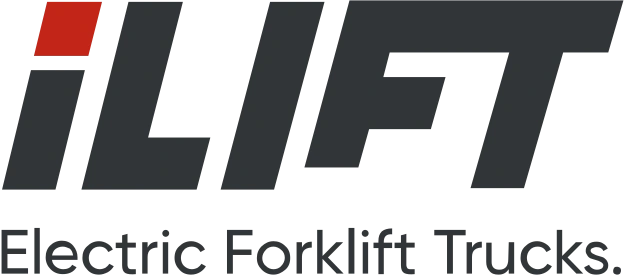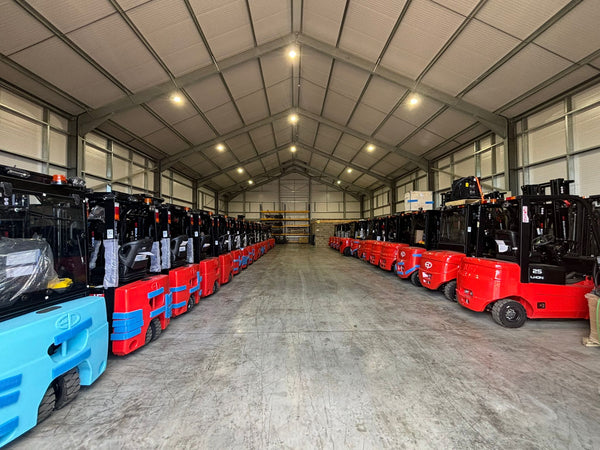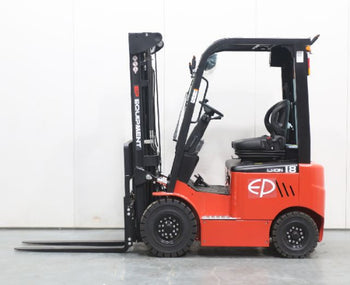The hum of electric forklifts is becoming increasingly common in modern warehouses, replacing the roar of internal combustion engines (ICE) and the familiar, yet demanding, presence of lead-acid battery-powered counterparts. As a warehouse manager, operations director, or business owner, you're constantly seeking ways to enhance efficiency, reduce costs, and elevate safety standards. The shift to lithium-ion forklifts isn't just a trend; it's a strategic move towards a more sustainable, productive, and cost-effective future for your material handling operations.
For decades, lead-acid and ICE forklifts have been the backbone of warehouses worldwide. While they’ve served their purpose, they come with inherent limitations: high maintenance, significant downtime for battery swaps or refueling, inconsistent power output, and a substantial environmental footprint. Lithium-ion technology has emerged as a game-changer, offering unparalleled efficiency, significant cost savings, and undeniable environmental benefits. If you're looking to modernize your fleet management and unlock new levels of warehouse efficiency, now is undeniably the time to consider the switch.
This guide provides a practical, step-by-step roadmap to help you navigate the transition of your existing forklift fleet to lithium-ion technology, addressing common challenges and highlighting key considerations for infrastructure upgrades and comprehensive forklift training.
Step 1: Assessing Your Current Operations & Needs
Before embarking on any significant fleet transformation, a thorough understanding of your current operational landscape is paramount. This initial assessment lays the groundwork for a successful and tailored fleet transition.
Fleet Audit: Inventory and Usage Patterns
Begin by conducting a comprehensive audit of your existing forklift fleet. Go beyond simply counting units. Document:
-
Types and Age: Identify the models, brands, and ages of your current ICE and electric (lead-acid) forklifts. Older equipment may be less efficient and more costly to maintain, making them prime candidates for replacement.
-
Existing Battery Technology: For electric forklifts, note the type, age, and condition of your lead-acid batteries. This will help quantify potential savings on battery replacements and maintenance.
-
Usage Patterns (The Power of Telematics): This is where modern technology shines. Implementing telematics systems on your existing fleet can provide invaluable data. Track metrics such as:
-
Actual Operating Hours: How many hours per day/shift is each forklift truly in use?
-
Idle Time: Identify periods when forklifts are running but not actively working.
-
Travel Distance: Map out typical travel routes and distances.
-
Lift Cycles: Understand the frequency and height of lifting operations.
-
Energy Consumption (for electric forklifts): Monitor current electricity usage for charging lead-acid batteries.
This detailed data will reveal underutilized or over-stressed equipment, helping you right-size your future electric forklifts fleet and accurately determine battery capacity needs.

Operational Analysis: Duty Cycles & Shift Patterns
With your audit data in hand, delve into a deeper operational analysis:
-
Duty Cycles: Understand the ratio of active work time to rest/charge time for each forklift. For instance, a forklift operating 8 hours straight with minimal breaks has a demanding duty cycle. Lithium-ion batteries excel in high-duty cycle applications due to their consistent power and opportunity charging capabilities.
-
Shift Patterns: Analyse your daily, weekly, and seasonal shift patterns. Do you run single, double, or triple shifts? Multi-shift operations often benefit most from lithium-ion, as a single Li-ion battery can often support multiple shifts with strategic opportunity charging, eliminating the need for battery swaps and dedicated charging rooms.
-
Current Charging Requirements: Document your current charging infrastructure for lead-acid batteries. This includes the number and type of chargers, their locations, and the electrical capacity available in those areas. This information is crucial for planning infrastructure upgrades.
Budgeting: Initial Investment vs. Total Cost of Ownership (TCO)
While lithium-ion forklifts often have a higher initial purchase price than their lead-acid or ICE counterparts, the long-term savings are substantial. Focus on the Total Cost of Ownership (TCO). When calculating TCO, consider:
-
Acquisition Cost: The upfront purchase price of the forklift and battery.
-
Energy Consumption: Lithium-ion batteries are significantly more energy-efficient (up to 30-40% more efficient than lead-acid), leading to lower electricity bills.
-
Maintenance: Li-ion batteries are virtually maintenance-free, eliminating the need for watering, acid neutralisation, or battery cleaning, drastically reducing labor and material costs.
-
Lifespan: Lithium-ion batteries typically last 2-4 times longer than lead-acid batteries (2,000-3,000 cycles vs. 1,500), reducing replacement frequency.
-
Downtime & Productivity: Factor in the cost of downtime for battery swaps (up to 15-30 minutes per swap, multiple times a day for multi-shift operations) and the inherent productivity loss due to lead-acid battery "fade" as charge depletes.
-
Labor Costs: Reduced labor for battery maintenance and swaps.
-
Space Optimisation: The elimination of dedicated battery changing rooms frees up valuable warehouse space, which can be repurposed for revenue-generating activities.
By calculating the TCO over the expected lifespan of the equipment, you’ll likely find a compelling return on investment (ROI) within 36 months, particularly for high-throughput operations.
Energy Audit: Understanding Current Consumption
Beyond the specific forklift usage, conduct an overall energy audit of your facility. This will help identify areas of excessive energy consumption and potential savings. For example, understanding peak demand charges and how intelligent lithium-ion charging systems can help manage these can lead to significant cost reductions. Analyzing your current energy bills and patterns will provide a baseline against which to measure the positive impact of your transition.
Step 2: Planning Your Lithium-Ion Adoption Strategy
Once you have a clear picture of your current operations and financial landscape, it's time to strategise your lithium-ion adoption.
Phased Approach vs. Full Overhaul
-
Phased Approach: This involves gradually replacing older lead-acid or ICE forklifts with lithium-ion models as they reach end-of-life or as budget allows. This approach minimises upfront capital expenditure and allows your team to adapt incrementally. It works well for operations with mixed shifts or where immediate full replacement isn't feasible.
-
Full Overhaul: Replacing your entire fleet simultaneously. This is often preferred by operations with high throughput, multiple shifts, and the capital to invest. It maximises the benefits of lithium-ion quickly, streamlining operations and simplifying training across the board.
The choice depends on your specific budget, operational intensity, and strategic goals.
Supplier Selection: Key Criteria
Choosing the right lithium-ion forklift provider is crucial for a successful transition. Look for a supplier that offers:
-
Proven Technology: Ensure they use reliable battery chemistry (e.g., LiFePO4, known for stability and longevity). Verify certifications like ISO 9001, UL1973, and IP67 for quality and safety.
-
Comprehensive Service and Support: What is their after-sales support like? Do they offer maintenance plans, readily available parts, and technical assistance?
-
Warranty: Understand the warranty terms for both the forklift and the lithium-ion battery.
-
Expertise: A supplier with deep knowledge of material handling and lithium-ion technology can provide invaluable guidance during your assessment and implementation phases. They should be able to assist with battery sizing, charger requirements, and integration.
Forklift Selection: Matching Models to Needs
Work closely with your chosen supplier to match specific lithium-ion forklift models to your operational needs. Consider:
-
Capacity and Mast Height: Ensure the new forklifts meet your load capacity and lifting height requirements.
-
Attachments: Verify compatibility with any specialised attachments you currently use.
-
Battery Specifications: Match the battery voltage (e.g., 24V, 36V, 48V, 72V, 80V) and Amp-hour (Ah) capacity to the forklift and your duty cycle needs. An oversized battery means unnecessary cost, while an undersized one leads to performance issues. Telematics data from your audit will be critical here.
-
Weight and Compartment Size: Lithium-ion batteries are often lighter and more compact, potentially offering more legroom for operators or allowing for smaller forklift designs. Ensure the battery fits the forklift's compartment.
-
Communication (CAN bus): Modern electric forklifts and lithium-ion batteries often communicate via a CAN bus system, ensuring optimal performance and safety.
Step 3: Crucial Infrastructure Upgrades
The transition to lithium-ion technology necessitates a review and potential upgrade of your facility’s electrical infrastructure.
Power Requirements: Assessing Electrical Infrastructure
-
Current Capacity: Evaluate your existing electrical panel capacity, main breaker size, and wiring. Lithium-ion chargers, especially fast chargers, draw significant power.
-
Voltage and Amperage: Ensure your electrical system can support the voltage and amperage requirements of the new chargers. You may need to install new circuits or even upgrade your main service entrance.
-
Professional Assessment: It’s highly recommended to consult with a qualified electrician or your lithium-ion forklift supplier’s technical team to assess your current infrastructure and recommend necessary upgrades.
Charging Stations: Types, Placement, and Safety
Unlike lead-acid batteries, which often require dedicated charging rooms with ventilation, lithium-ion batteries do not off-gas and offer much more flexibility.
-
Types of Chargers:
-
Fast Charging: Allows for rapid charging (e.g., 80% charge in 1-2 hours), ideal for multi-shift operations where forklifts need to be back in service quickly.
-
Opportunity Charging: The key benefit of Li-ion. Operators can plug in forklifts during short breaks, lunch, or any downtime without damaging the battery or shortening its lifespan. This virtually eliminates battery swapping and extended downtime.
-
Placement: Strategic placement of charging stations is vital for maximizing productivity. Position chargers close to high-traffic areas, break rooms, or common staging zones to facilitate easy opportunity charging. This minimizes travel time to and from charging points.
-
Safety Considerations: While safer than lead-acid, proper safety protocols are still essential. Ensure charging areas are:
-
Clearly Marked: Designate charging zones.
-
Clutter-Free: Keep the area clear of obstructions and flammable materials.
-
Equipped for Emergencies: Have appropriate fire extinguishers (e.g., Class D for lithium fires, though specialised extinguishers are often recommended by manufacturers) and emergency shut-offs readily accessible.
-
Proper Connection: Ensure operators are trained on correct plug and unplug procedures to prevent arcing or damage.
Battery Management Systems (BMS): Importance for Safety and Longevity
Every lithium-ion battery comes equipped with an integrated Battery Management System (BMS). This intelligent system is critical for:
-
Safety: The BMS monitors individual cell voltage and temperature, preventing overcharging, over-discharging, and overheating—conditions that could lead to thermal runaway.
-
Longevity: It balances the charge across all cells, ensuring they discharge and charge uniformly, which significantly extends the battery’s lifespan.
-
Performance: The BMS optimises power delivery, maintaining consistent voltage throughout the discharge cycle, which prevents the "fade" experienced with lead-acid batteries. It also provides diagnostic data for predictive maintenance.
Space Optimisation: Reclaiming Valuable Real Estate
One of the often-overlooked benefits of transitioning to lithium-ion is the ability to reclaim space. Without the need for dedicated battery changing rooms, washing stations, or bulky charging equipment, you can repurpose this valuable square footage for additional storage, new production lines, or expanded staging areas, directly contributing to warehouse efficiency.

Step 4: Comprehensive Training for Your Team
Any successful technological transition hinges on effective training. Your operators and maintenance staff will need to adapt to new procedures and characteristics of lithium-ion forklifts.
Operator Training: Adapting to New Habits
Operators will quickly appreciate the consistent power and lack of "fade" throughout a shift. Training should cover:
-
Operation Differences: While basic controls remain the same, emphasize the consistent power output and the ability to operate at full performance until the battery is nearly depleted.
-
Charging Procedures: The most significant change will be the shift to opportunity charging. Train operators on how and when to plug in forklifts during breaks, between tasks, or any downtime, even for short periods. Reinforce proper connection and disconnection.
-
Safety Protocols: Review general forklift safety, plus specific guidelines for lithium-ion battery handling and charging. This includes proper personal protective equipment (PPE) and emergency procedures.
Maintenance Staff Training: Specialised Knowledge
While lithium-ion batteries require significantly less routine maintenance than lead-acid (no watering, cleaning, or equalizing), your maintenance team will need specialised training on:
-
Battery Management Systems (BMS): Understanding how to read BMS diagnostics, interpret error codes, and troubleshoot basic issues.
-
Lithium-Ion Battery Components: Familiarity with the battery pack, cells, and connectors.
-
Specialised Tools (if any): Any specific tools or software required for Li-ion battery diagnostics or service.
-
Reduced Routine Tasks: Highlight the reduction in daily/weekly maintenance tasks, allowing them to focus on other critical areas.
Safety Protocols: Specific Guidelines
Beyond general forklift safety, establish clear safety guidelines for lithium-ion batteries and charging equipment:
-
Emergency Procedures: What to do in case of a fire or a damaged battery.
-
Spill Kits: While acid spills are eliminated, understand procedures for any electrolyte leakage (rare but possible).
-
Ventilation: Although off-gassing isn't an issue, ensure good general ventilation in charging areas.
-
Prohibited Activities: Emphasise "no smoking" rules and precautions against physical damage to batteries.
Step 5: Implementation and Post-Transition Optimisation
With planning and training complete, it's time for implementation and ongoing optimisation.
Pilot Program (Optional but Recommended)
For larger fleets, consider a pilot program. Introduce a small number of lithium-ion forklifts into a specific area or shift. This allows your team to gain hands-on experience, identify any unforeseen challenges, and refine procedures before a full-scale rollout. A pilot program provides real-world data and helps build confidence within your workforce.
Monitoring Performance: Key Performance Indicators (KPIs)
Once implemented, continuously monitor the performance of your new fleet. Key Performance Indicators (KPIs) to track include:
-
Energy Consumption: Compare electricity usage before and after the transition.
-
Uptime: Track the percentage of time forklifts are operational versus undergoing charging or maintenance.
-
Maintenance Costs: Monitor savings on battery-related maintenance.
-
Productivity: Evaluate improvements in material movement per hour or overall throughput.
-
Operator Behavior: Use telematics to ensure proper opportunity charging habits are forming.
Continuous Improvement: Adjusting and Optimising
Use the data collected from your KPIs to make continuous adjustments. This might involve:
-
Optimising Charging Schedules: Fine-tuning when and where forklifts are charged to maximise opportunity charging benefits.
-
Rebalancing Fleet Utilisation: Adjusting assignments to ensure all forklifts are utilised efficiently.
-
Refining Operational Flows: Identifying new efficiencies thanks to the consistent power and reduced downtime of lithium-ion forklifts.
Benefits Beyond the Basics: Why the Switch Pays Off
The decision to transition to lithium-ion forklifts extends far beyond simple equipment replacement. It’s an investment in a more efficient, sustainable, and profitable future.
-
Cost Savings: As discussed, the long-term Total Cost of Ownership (TCO) is significantly lower due to reduced energy bills, minimal maintenance requirements, and longer battery lifespans. This directly impacts your bottom line.
-
Increased Productivity: Opportunity charging eliminates battery swaps and cooling periods, drastically reducing forklift downtime. Consistent power output throughout the shift means no performance degradation, leading to higher throughput and more consistent work cycles.
-
Environmental Impact: Lithium-ion forklifts produce zero emissions at the point of use, improving indoor air quality for your employees. They also consume less electricity, reducing your facility’s carbon footprint. Unlike lead-acid batteries, they contain no hazardous sulfuric acid, and their high recyclability potential further enhances their sustainability credentials.
-
Enhanced Safety: The sealed design of lithium-ion batteries eliminates acid spills, corrosive fumes, and the risk of burns associated with lead-acid batteries. The integrated Battery Management System (BMS) provides superior thermal protection, significantly reducing the risk of overheating.
Conclusion: Embracing the Future of Forklift Fleets
The seamless transition of your fleet to lithium-ion forklifts is not merely an operational upgrade; it's a strategic imperative for modern warehouse management. By systematically assessing your needs, carefully planning your adoption, investing in crucial infrastructure upgrades, providing comprehensive forklift training, and continuously optimising your operations, you can unlock unparalleled levels of warehouse efficiency, substantial cost savings, and a significantly reduced environmental impact.
The future of material handling is electric, intelligent, and driven by lithium-ion power. Don't be left behind. Start planning your transition today and move confidently towards a more productive, profitable, and sustainable warehouse.
Ready to explore lithium-ion solutions for your warehouse? Get in touch with us at: enquiry@ilift.co.uk





